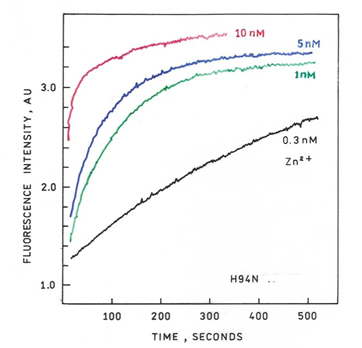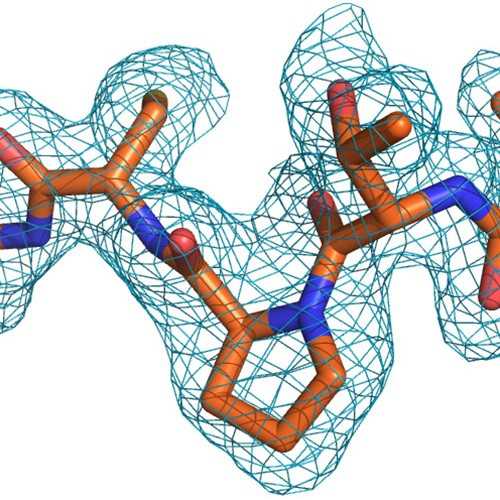H94N-apoCA-tagRFP Biosensor Protein
H94N-apoCA-tagRFP Biosensor Protein is a fluorescence-based biosensor with high sensitivity (KD = 0.22 nM) for measuring zinc.
Together with 4-(dimethylaminophenyl)benzoxazolyl sulfonamide, one can measure free zinc in aqueous solution at concentrations in the picomolar range (PMID 22430627, PMID 19152866, PMID: 17163650). It responds rapidly (see figure) to changes in free zinc at low levels which makes it useful for following rapid changes in free zinc concentration. It is one of our excitation ratiometric sensors, which makes accurate, reproducible calibration simple and minimizes most artifacts.
Read plog post from Dr. Richard Thompson at Pokegama Technologies, Improving Zinc Ion Quantitation with Unique Biosensor Proteins and Buffers.
H94N-apoCA-tagRFP Biosensor Protein is a fluorescence-based biosensor with high sensitivity (KD = 0.22 nM) for measuring zinc.
Together with 4-(dimethylaminophenyl)benzoxazolyl sulfonamide, one can measure free zinc in aqueous solution at concentrations in the picomolar range (PMID 22430627, PMID 19152866, PMID: 17163650). It responds rapidly (see figure) to changes in free zinc at low levels which makes it useful for following rapid changes in free zinc concentration. It is one of our excitation ratiometric sensors, which makes accurate, reproducible calibration simple and minimizes most artifacts.
Read plog post from Dr. Richard Thompson at Pokegama Technologies, Improving Zinc Ion Quantitation with Unique Biosensor Proteins and Buffers.
| Product Type: | Protein |
| Name: | H94N-apoCA-tagRFP biosensor protein |
| Extinction Coefficient: | ε555 nm = 100,001 |
| Molecular Weight: | 60,000 Da |
| Variant MPN: | T-0010 |
| Format: | Solution in pH 7.5 buffer |
| Purity: | >95% |
| Tested Applications: | Measuring free zinc ion concentrations |
| Comments: | Fluorescent-labeled zinc free apoprotein; fluorescent label excitation maximum 555 nm, preferred emission wavelength 610 nm |
| Storage: | +4C |
| Shipped: | Cold packs |

- T. K. Hurst, D. Wang, R.B. Thompson, C.A. Fierke, ÒCarbonic anhydrase II-based metal ion sensing: Advances and new perspectives,Ó Biochimica et Biophysica Acta (Proteins and Proteomics)1804, 393-403 (2010). PMID: 19818877; NIHMSID 157045.
- R.A. Bozym, T. Hurst, N. Westerberg, A.V. Stoddard, C.A. Fierke, C.J. Frederickson, R.B. Thompson, ÒDetermination of zinc using carbonic anhydrase-based fluorescence biosensors,Ó in Methods in Enzymology: Fluorescence Spectroscopy Vol. 450 (L. Brand and M.L. Johnson, editors) New York: Elsevier, pp 279-301 (2008). PMID 19152866.
- R. A. Bozym, A. K. Stoddard, C. A. Fierke, and R. B. Thompson, ÒMeasuring picomolar exchangeable zinc in PC-12 cells using a ratiometric fluorescence biosensor,Ó ACS Chemical Biology1(2) 103 Ð 111 (2006) PMID: 17163650
If you publish research with this product, please let us know so we can cite your paper.


